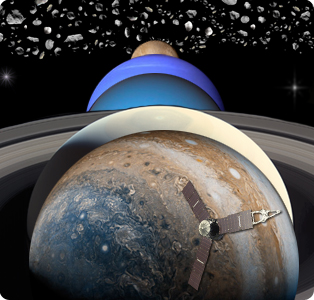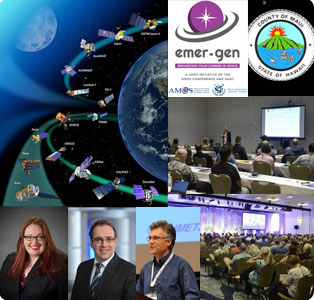Jupiter Observations with Juno; Looking Toward Solar System Complete Exploration
|
MONDAY Highlights…
|

![]() = All times
= All times
for terrestrial events in local time unless noted.
![]() = All times for international terrestrial events in local time unless noted.
= All times for international terrestrial events in local time unless noted.
![]() = All times for space events, and…
= All times for space events, and…
![]() = All times for international space / astro events in Hawaii Standard Time unless noted. Add 10 hours to obtain UT (‘Universal Time’).
= All times for international space / astro events in Hawaii Standard Time unless noted. Add 10 hours to obtain UT (‘Universal Time’).
Weekly Planet Watch – Evening Planets: Venus (WSW), Mars (SE), Jupiter (SW), Saturn (S), Uranus (E), Neptune (SE); Morning Planets: Mercury (ENE).
Maui, Hawai`i Hosts Inaugural Emer-Gen and Annual AMOS Conferences in Partnership with SGAC
The 1st annual Emer-Gen Conference, a joint initiative of Advanced Maui Optical and Space Surveillance Technologies (AMOS) and the Space Generation Advisory Council (SGAC), will be held in Maui September 9-11 with an anticipated 30 young professionals and students 35 and under interested in careers in space science. The program will offer opportunities to expand skills and remain abreast of recent scientific developments by way of mentoring from space specialists, networking, expert-led technical short courses and workshops, and professional development sessions. Main topics to be covered are communications in diverse settings, effective leadership, space traffic management, risk assessments, space debris and mitigation analysis using ESA DRAMA software, operational analytics, theory and application, space surveillance and tracking, and space situational awareness. Over 40 presenters include (L-R) Secure World Foundation Washington Office Director Victoria Samson, ESA/ESOC Space Debris Analyst Tim Flohrer, and Francois Laporte of CNES. Boeing, Lockheed Martin, Northrop Grumman, and University of Hawai`i are among 29 exhibitors. Directly following the inaugural Emer-Gen event is the 19th Annual AMOS Conference September 11-14 opening with a keynote address by Major General Stephen Whiting. The conference is a cross section of government, private, and academic participation and is expected to have ~1,000 in attendance with a Wednesday Livestream opening session in designated overflow rooms. (Image Credits: AMOS, NASA, Secure World Foundation, ESA, J. Mai, CNES, Space Ops, County of Maui) |
Continued from…
TUESDAY
|
WEDNESDAY
![]() Sep 5 — Voyager 1, Interstellar Space: NASA spacecraft begins 42nd year in space today, launched Sep 5, 1977; farthest spacecraft from Earth, first to reach interstellar space.
Sep 5 — Voyager 1, Interstellar Space: NASA spacecraft begins 42nd year in space today, launched Sep 5, 1977; farthest spacecraft from Earth, first to reach interstellar space.
![]() Sep 5-6 — Radboud University, Noordwijk, The Netherlands: Space VLBI Workshop.
Sep 5-6 — Radboud University, Noordwijk, The Netherlands: Space VLBI Workshop.
![]() Sep 5-7 — Astronomical Institute of Slovak Academy of Sciences, Stara Lesna, Slovakia: Workshop: Physics of Comets after the Rosetta Mission – Unresolved Problems.
Sep 5-7 — Astronomical Institute of Slovak Academy of Sciences, Stara Lesna, Slovakia: Workshop: Physics of Comets after the Rosetta Mission – Unresolved Problems.
![]() Sep 5-7 — DARPA, National Harbor MD: D60 – Defense Advanced Research Projects Agency (DARPA) 60th Anniversary conference; at Gaylord National Resort & Convention Center.
Sep 5-7 — DARPA, National Harbor MD: D60 – Defense Advanced Research Projects Agency (DARPA) 60th Anniversary conference; at Gaylord National Resort & Convention Center.
![]() Sep 5 — Moon: 11.4° S of Castor, 14:00; 7.7° S of Pollux, 18:00.
Sep 5 — Moon: 11.4° S of Castor, 14:00; 7.7° S of Pollux, 18:00.
![]() Sep 5 — Mercury: 1.00° NNE of Regulus, 17:00.
Sep 5 — Mercury: 1.00° NNE of Regulus, 17:00.
THURSDAY
![]() Sep 6 — Johnson Space Center, NASA, Houston TX: Expedition 58/59 Crew Press Conference; featuring Astronauts David Saint-Jacques, Jeremy Hansen, Anne C. McClain, Oleg Kononenko – and Canadarm2 operation simulation.
Sep 6 — Johnson Space Center, NASA, Houston TX: Expedition 58/59 Crew Press Conference; featuring Astronauts David Saint-Jacques, Jeremy Hansen, Anne C. McClain, Oleg Kononenko – and Canadarm2 operation simulation.
![]() Sep 6 — Cornell University, Ithaca NY: Lecture: The Gould’s Belt Distances Survey (GOBELINS) and a Few Other Cools Things VLBI Can Do For You; by Laurent Loinard from National University of Mexico.
Sep 6 — Cornell University, Ithaca NY: Lecture: The Gould’s Belt Distances Survey (GOBELINS) and a Few Other Cools Things VLBI Can Do For You; by Laurent Loinard from National University of Mexico.
![]() Sep 6, 7 — Jet Propulsion Laboratory, NASA, Caltech, Pasadena CA: von Kármán Lecture Series 2018: NASA@60: The Role of the Robots; with moderator Preston Dyches, and panelists Rob Manning, Julie Webster, Charles Norton, Anne Marinan.
Sep 6, 7 — Jet Propulsion Laboratory, NASA, Caltech, Pasadena CA: von Kármán Lecture Series 2018: NASA@60: The Role of the Robots; with moderator Preston Dyches, and panelists Rob Manning, Julie Webster, Charles Norton, Anne Marinan.
![]() Sep 6 — Moon: 1.1° SSW of Beehive Cluster, 16:00.
Sep 6 — Moon: 1.1° SSW of Beehive Cluster, 16:00.
FRIDAY
![]() Sep 7 — Juno, Perijove 15 / 14th Science Flyby, Jupiter Orbit: NASA craft in 53-day orbit to come within ~3,500 km of Jupiter cloud tops during Perijove 15, its 15th close flyby of Jupiter and 14th science flyby with instruments turned on.
Sep 7 — Juno, Perijove 15 / 14th Science Flyby, Jupiter Orbit: NASA craft in 53-day orbit to come within ~3,500 km of Jupiter cloud tops during Perijove 15, its 15th close flyby of Jupiter and 14th science flyby with instruments turned on.
![]() Sep 7 — Canada Institute – The Wilson Center, Washington DC: Over the Horizon: A New Era for Canada-U.S. Space Cooperation?
Sep 7 — Canada Institute – The Wilson Center, Washington DC: Over the Horizon: A New Era for Canada-U.S. Space Cooperation?
![]() Sep 7 — Moon: At perigee (360,917 km), 15:24.
Sep 7 — Moon: At perigee (360,917 km), 15:24.
![]() Sep 7 — Neptune: At opposition 08:00, magnitude 7.8.
Sep 7 — Neptune: At opposition 08:00, magnitude 7.8.
![]() Sep 7 — Apollo Asteroid 2008 PW4: Near-Earth Flyby (0.075 AU)
Sep 7 — Apollo Asteroid 2008 PW4: Near-Earth Flyby (0.075 AU)
![]() Sep 7 — Amor Asteroid 2007 RZ8: Near-Earth Flyby (0.096 AU)
Sep 7 — Amor Asteroid 2007 RZ8: Near-Earth Flyby (0.096 AU)
SATURDAY
![]() Sep 8-9 — SpaceX, Launch Falcon 9 / Telstar 18 Vantage, SLC-40 Cape Canaveral FL: SpaceX Falcon 9 to launch communications satellite for Telesat from Launch Complex 40 and attempt booster landing aboard ‘Of Course I Still Love You’ drone ship in Atlantic Ocean; launch window 23:28 – 03:28.
Sep 8-9 — SpaceX, Launch Falcon 9 / Telstar 18 Vantage, SLC-40 Cape Canaveral FL: SpaceX Falcon 9 to launch communications satellite for Telesat from Launch Complex 40 and attempt booster landing aboard ‘Of Course I Still Love You’ drone ship in Atlantic Ocean; launch window 23:28 – 03:28.
![]() Sep 8 — Mauna Kea Visitor Information Station, Mauna Kea HI (2,800 meters): Star Gazing program, 19:00-22:00, weather permitting, free.
Sep 8 — Mauna Kea Visitor Information Station, Mauna Kea HI (2,800 meters): Star Gazing program, 19:00-22:00, weather permitting, free.
![]() Sep 8 — Tucson L5 Space Society – NSS Chapter, Tucson AZ: Tucson L5 Space Society monthly meeting.
Sep 8 — Tucson L5 Space Society – NSS Chapter, Tucson AZ: Tucson L5 Space Society monthly meeting.
![]() Sep 8-16 — Merritt Astronomical Society, Loon Lake, Saskatchewan, Canada: Merritt Fall Star Quest 2018.
Sep 8-16 — Merritt Astronomical Society, Loon Lake, Saskatchewan, Canada: Merritt Fall Star Quest 2018.
![]() Sep 8 — Moon: 1.7° NNE of Regulus. 04:00; 0.89° NNE of Mercury, 13:00.
Sep 8 — Moon: 1.7° NNE of Regulus. 04:00; 0.89° NNE of Mercury, 13:00.
SUNDAY
![]() Sep 9-11 — Maui Economic Development Board, Inc, SGAC, Maui HI: Emer-Gen 1st Annual Conference; designed for professionals and students under 35 interested in careers in space, includes networking, mentoring, courses, and professional development sessions.
Sep 9-11 — Maui Economic Development Board, Inc, SGAC, Maui HI: Emer-Gen 1st Annual Conference; designed for professionals and students under 35 interested in careers in space, includes networking, mentoring, courses, and professional development sessions.
![]() Sep 9-15 — National Engineering University of Lima, National University of Saint Anthony the Abbot in Cuzco, Ollantaytambo, Peru: 8th International Workshop on Astronomy and Relativistic Astrophysics (IWARA2018).
Sep 9-15 — National Engineering University of Lima, National University of Saint Anthony the Abbot in Cuzco, Ollantaytambo, Peru: 8th International Workshop on Astronomy and Relativistic Astrophysics (IWARA2018).
![]() Sep 9-16 — Association of Space Explorers, Minsk, Belarus: 31st Planetary Congress of the ASE: Creating the Future of Space.
Sep 9-16 — Association of Space Explorers, Minsk, Belarus: 31st Planetary Congress of the ASE: Creating the Future of Space.
![]() Sep 9 — Moon: New Moon, 08:02.
Sep 9 — Moon: New Moon, 08:02.
![]() Sep 9 — Epsilon Perseid Meteor Shower Peak: Appearing to radiate from the constellation Perseid the September Epsilon Perseids can reach up to 5 per hour traveling at ~65 km per second; very favorable viewing in 2018 due to New Moon.
Sep 9 — Epsilon Perseid Meteor Shower Peak: Appearing to radiate from the constellation Perseid the September Epsilon Perseids can reach up to 5 per hour traveling at ~65 km per second; very favorable viewing in 2018 due to New Moon.

